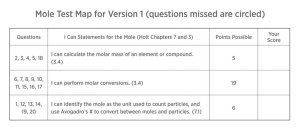Making Failure Harder Work Than Passing
A rigorous intervention pushes students who might be satisfied with a D to aim higher.
Your content has been saved!
Go to My Saved Content.Chemistry seems to inspire a D mentality: A significant number of students just want to pass the class to meet their graduation requirement, and do it with as little effort as possible.
Take Evelyn, for example. A junior in my chemistry class in the spring of 2015, Evelyn was bright, but she didn’t see chemistry as relevant to her present or future, so she kept her head low, didn’t engage with the material, missed about 20 percent of the class, and seemed to target a grade of 60 percent. That was at the beginning of the year.
By the end of the term, Evelyn was sitting in the front row, volunteering to demonstrate how to solve problems, and getting frustrated with herself when her final grade in the class was a B.
Evelyn’s grade had gone from a 60 percent to an 85 percent, but the real changes that I saw in her were much more rewarding than an improved grade point average—she was engaged in learning, taking risks, and working harder than she had once believed she could.
Many students will avoid working hard in a class that they see as challenging because of the risk involved. If they work hard and fail, they’ve proven their inadequacy. But if they don’t work hard and manage to get a D, their pride remains intact and they haven’t lost anything. That’s why I make failing harder work than passing.
Turning “I Can’t” Into “I Can”
Here’s the typical learning cycle for a unit in my chemistry class.
1. I present the students with a list of learning objectives for the unit. The list is short and worded as “I can” statements. For example, these are some of the objectives for the unit on dimensional analysis and the mole (Holt Chapters 7 and 3):
- I can identify the mole as the unit used to count particles, and use Avogadro’s number to convert between moles and particles. (7.1)
- I can calculate the molar mass of an element or compound. (3.4)
- I can perform molar conversions (use the Mole Road Map). (3.4)
2. There are guided practice opportunities for students on each of these objectives. I also use formative assessments, which can be homework, quizzes, or labs. They count for very little in the grade. The point of these assessments is to give kids a lot of practice with the material in a low-risk environment, and to provide feedback on their progress toward mastering the objectives.
3. Students prepare for the summative assessment. After a period of guided practice, formative assessment, feedback, and review for each objective, the students get ready for the unit test. This summative assessment is weighted heavily in determining the grade, so we practice the types of questions they’ll encounter on it.
4. Students take the summative assessment. A passing grade is 70 percent. Students who don’t pass have to retake the assessment. I give them a test map like the one below showing which objectives they didn’t master. The test map is accompanied by an intervention worksheet organized by objective. Students are expected to complete the worksheet sections that they need to practice in order to improve their score.

Differentiation and Incentive
The final stage of the learning cycle is where instruction is truly differentiated. Students who are required to retake their test must show me their completed intervention worksheet so I can see if they’re getting closer to the targets. Usually they raise their grade to a passing score on the first retake. Sometimes it takes a couple of rounds, but they have a time limit: They have to finish the retake cycle before the next unit test.
Students who score below 90 percent but have passed the assessment may also go through this cycle. Many students in the 70–89 percent band opt to do the intervention and retake the test.
Students who are content to score at or below 60 percent are faced with extra work they wouldn’t have to do if they scored just 10 points higher. This cycle helps them understand that, if they can do the work required to get 70 percent, it’s not much more work to get an even higher grade. And the progress is addictive.
This isn’t a canned curriculum. I write my own tests, quizzes, test maps, intervention worksheets, homework assignments, and labs. I use sample questions from the state tests as a guide for the types of questions to include on my exams. I do all of the grading and fill out the test maps by hand. It’s time consuming, and I have to take work home with me every single day. I do my grading while my own children do their homework. While this learning cycle works, it requires a lot of effort. But I think the final result is worth all that effort.
UPDATE
For the past two years, I’ve been teaching chemistry and physics in an International Baccalaureate program at a school in Albania. My own children have been students in my classes. I’ve continued to use this method of instruction with intervention and retesting, and I’ve also added rewriting lab reports for the B and C rubrics as part of the IB Science Criteria.
More than 90 percent of my students are English language learners, and they definitely appreciate the chance to retake their assessments and use the feedback I give them. One of the Approaches to Learning (ATL) skills that the IB program emphasizes is giving and receiving meaningful feedback. The method I outline above provides an excellent opportunity for students to work on this ATL skill.
In addition, the Learner Profile for IB students includes the attribute of Risk Taker. I think students who believe teachers are willing to help them learn from their mistakes are more likely to be risk takers and invest the time and energy needed to be successful. So all the effort still seems worthwhile.
